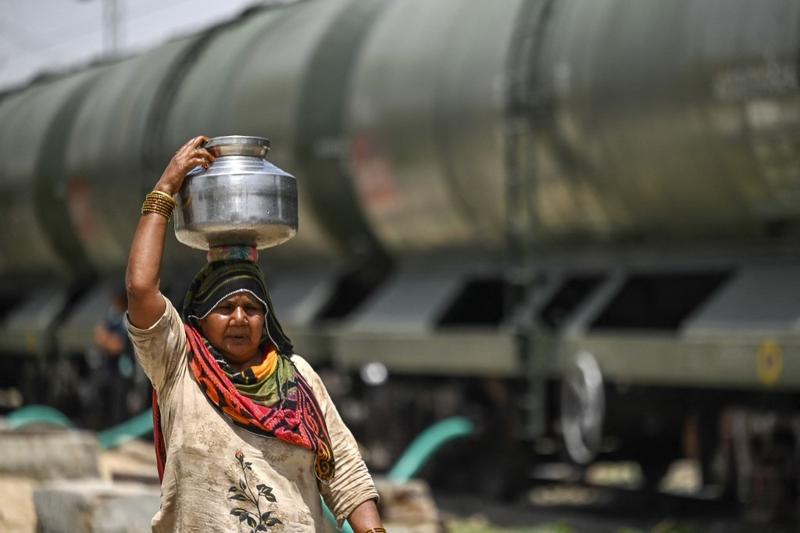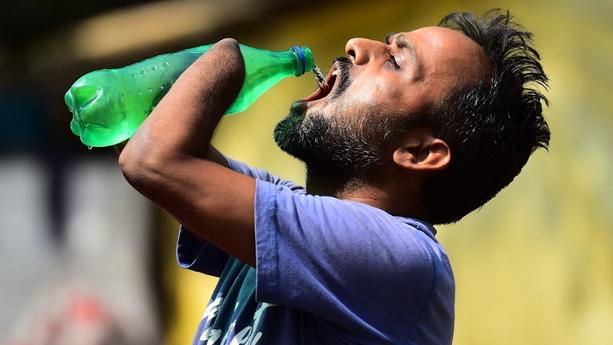 This photograph taken on May 11, 2022 shows a woman carrying a pitcher filled water supplied by a special train on a hot summer day in Pali, India. (PRAKASH SINGH / AFP)
This photograph taken on May 11, 2022 shows a woman carrying a pitcher filled water supplied by a special train on a hot summer day in Pali, India. (PRAKASH SINGH / AFP)
NOIDA, India - As the scorching sun beat down on his fruit cart, Mohammad Ikrar dreaded another day of tossing out dozens of rotting mangoes and melons - a regular practice as India grappled with an unprecedented heatwave this month.
The 38-year-old does not own a refrigerator, meaning his fruit quickly spoils. By the end of the day, any leftover produce is usually only good to be fed to passing stray cows.
Since April, Ikrar said he has lost up to 3,000 rupees ($39) a week - nearly half of his average weekly earnings.
"This heat is torturous. But if I want to buy an AC (air conditioner) or fridge one day, I have to do this," said Ikrar, wearing a full sleeve shirt and white headwrap to keep cool in the 44 degrees Celsius (111.2F) heat.
Almost 323 million people across the country are at high risk from extreme heat and a lack of cooling equipment such as fans and refrigerators, found a report released last week by Sustainable Energy for All (SE4ALL), a UN-backed organization
Heavy rain and thunderstorms in the New Delhi area early on Monday brought the scorching temperatures down to about 20 degrees, with Mahesh Palawat, vice president of Skymet, a private weather forecasting agency saying in a social media post that the heatwave would not come back "anytime soon" in the region.
But temperatures are set to soar again to about 40 degrees later in the week, according to India's weather office.
ALSO READ: Poor workers bear the brunt of India's heatwave
Monday's storm knocked out power in large parts of the capital city - a problem Ikrar has become accustomed to this summer.
At home, he and his family suffer hours-long power cuts day and night, rendering the ceiling fan useless in their one-room house in Noida, a satellite city of New Delhi.
Almost 323 million people across the country are at high risk from extreme heat and a lack of cooling equipment such as fans and refrigerators, found a report released last week by Sustainable Energy for All (SE4ALL), a UN-backed organization.
India topped a list of "critical" countries, also including Indonesia and Pakistan, which have the largest populations facing heat-related dangers ranging from immediate deaths from overheating to impacts on food security and incomes.
Temperatures in the New Delhi area soared above 49 degrees in mid-May after India recorded its hottest March in 122 years and an unusually hot April. Temperatures are expected to cool as monsoon rains arrive in June.
ALSO READ: India bans wheat exports as heatwave hurts crop
The prevailing heatwave, particularly in the north, west and central parts of the country, might lead to a curb in the yield of wheat crops, besides contributing to inflation and adversely affecting overall growth, the Moody's rating agency said in a report on Sunday.
Notably, the major wheat-growing states in India are Punjab, Haryana, Rajasthan, Madhya Pradesh and parts of Uttar Pradesh. Over the past couple of weeks, mercury in these states has risen to over 45 degrees, thus throwing normal life out of gear as people keep themselves indoors, particularly during the daytime.
 A man drinks water from a bottle on a hot summer day in Allahabad on April 30, 2022. (SANJAY KANOJIA / AFP)
A man drinks water from a bottle on a hot summer day in Allahabad on April 30, 2022. (SANJAY KANOJIA / AFP)
Due to the prevailing heatwave in north and western states, the estimates of wheat production in the current season have fallen by over 5 percent.
The federal government had recently decided to curb wheat exports considering the possible fall in wheat production this season.
"Over the longer term, India's highly negative credit exposure to physical climate risks means its economic growth will likely become more volatile as it faces increasing, and more extreme, incidences of climate-related shocks," the report reads.
'Worrying urban trends'
India's electricity demand has also hit a record high with a surge in the use of air conditioning triggering the worst power crisis in more than six years.
Although nearly all households in India have access to electricity, only a fraction of its 1.4-billion population owns any cooling appliances, found SE4ALL.
As demand for cooling will soar in coming years, it will also add pressure to India's over-stretched electricity systems and lead to a potential increase in planet-warming emissions, said Brian Dean, head of energy efficiency and cooling at SE4ALL.
"(This) in turn further exacerbates the risk of longer and more extreme heatwaves," he told the Thomson Reuters Foundation.
He urged authorities to quickly implement the India Cooling Action Plan, launched in 2019, which aims to cut cooling demand by up to 25 percent by 2038 through measures including developing new cooling technology and designing buildings with natural airflow.
ALSO READ: India: Temperatures break records as heat wave scorches region
With Xinhua inputs



